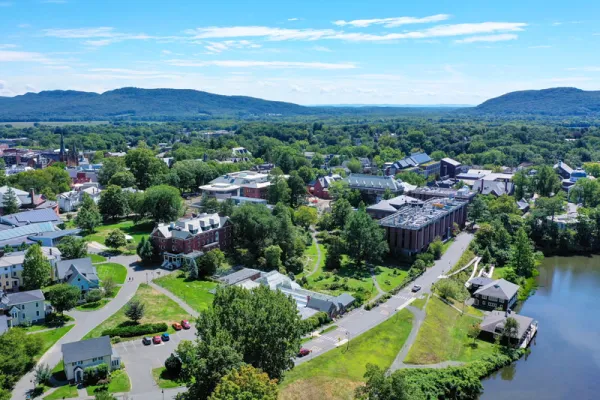Smith’s Geothermal Energy Project: Frequently Asked Questions
News of Note

Published May 2, 2022
In summer 2022, Smith will begin work on a bold geothermal campus energy project that will lower the college’s carbon emissions by 90 percent, allowing the college to become carbon neutral by 2030. Learn more about the project in this FAQ.
The Basics
What is Smith doing?
Smith College will break ground in May on a bold geothermal campus energy project that will lower the college’s carbon emissions by 90%, allowing Smith to become carbon neutral by 2030.
How is Smith doing that?
Smith is completely revamping its campus-wide heating and cooling system, replacing the college’s 70-year-old, fuel-fired heating system with a state-of-the-art, electricity-fueled geothermal heating and cooling system.
How is Smith’s project distinctive?
Although many colleges have pledged to become carbon neutral between now and 2050, Smith is one of only a handful of schools to achieve carbon neutrality by significantly reducing fossil fuel consumption onsite, rather than by relying on carbon offsets or by replacing fossil fuels with biofuels, for example.
What benefits does the new geothermal system provide?
Many. Once complete, the geothermal energy system will reduce Smith’s campus carbon emissions by 90%, reduce consumption of water by more than 10% and improve local air quality. The system will also improve building comfort and lower costs to the college.
How does this project help Smith College become carbon neutral?
Smith’s carbon footprint is made up of a number of emissions sources, including fossil fuel combustion to produce electricity, to heat buildings, and to power vehicles and equipment. Most of these emissions are in the service of heating buildings. To reduce carbon emissions, Smith will replace the combustion of fossil fuels with electricity that is produced by wind, solar or other fossil fuel-free sources. (This process is sometimes referred to as “electrification.”) The Geothermal Campus Energy Project will electrify the heating and cooling system for the Smith campus, reducing operational carbon emissions by approximately 90%.
How does this project help Smith, Northampton and Massachusetts become carbon neutral?
Smith’s carbon emissions are approximately 10% of those of the City of Northampton. Smith’s 2030 carbon neutrality goal will help the City of Northampton and the Commonwealth of Massachusetts meet their 2050 carbon neutrality goals.
When will Smith’s geothermal system be built?
The work will be done in three phases, between 2022 and 2028.
What is the construction timeline for the project?
Work on the North Campus, near Cutter-Ziskind on Henshaw Ave., will begin in summer 2022 and run through summer 2024. The second phase, encompassing the Smith Quadrangle on Kensington Ave., will begin in 2023 and run through summer 2025. Construction on the final phase of the project, encompassing Smith’s central campus, will run from summer 2025 to summer 2028.
How can I stay up to date on construction, road closures, etc.?
We have set up a project website to provide regular updates on construction and other issues.
The Technology
How does geothermal heat exchange work?
Geothermal heat exchange harnesses the stable temperature in the earth below the frost line (four feet) and transfers it – using piped water–from the ground to an energy plant, and then on to individual buildings for heating and cooling.
What is a heat pump?
A heat pump is an electric device that moves thermal (hot and cold) energy from one location to another. (Think of your refrigerator, or a mini-split.) This geothermal heat exchange allows the heat pumps to work at a higher efficiency than traditional heating and cooling systems.
Where will Smith’s geothermal heat pumps be located?
When the Geothermal Campus Energy Project is complete, there will be three energy centers housing the heat pumps. These energy centers will be located in the Capen Boiler building; in the former boiler room and coal pocket in Emerson House; and in the existing Chiller Plant on West Street.
How will the heat pumps be powered?
The heat pumps will run on electricity from a fossil fuel-free source, such as solar or wind. 30% of Smith’s electricity use already comes from solar electricity produced in Farmington, Maine. Smith will procure additional renewable electricity in the future.
Environmental Impacts
What are the environmental effects of this project?
Once complete, the geothermal energy system will reduce Smith’s campus carbon emissions by 90%, reduce consumption of water by more than 10% and improve local air quality. Smith’s new geothermal project will be conducted in accordance with all city, state and federal regulations.
Will this project affect fish and other wildlife in the Mill River?
No. This project does not involve the Mill River or Paradise Pond.
Will this project affect the look of the campus?
No. The geothermal system will be underground. Once construction is complete, there will be no visible changes to campus appearance.
Direct Effects
Will the heating systems in Smith’s buildings change?
Yes. This project will involve most of the buildings on campus. Some buildings will need extensive updating to make heating systems compatible with the new system. Newer or recently renovated buildings will need very little work.
Will rooms be more comfortable?
Yes. This project modernizes infrastructure that is up to 70 years old. It will improve reliability and, importantly, it will improve comfort. Heating will be much more even, and air conditioning will be added to more than 20 buildings across campus.
Photograph by Jeff Baker